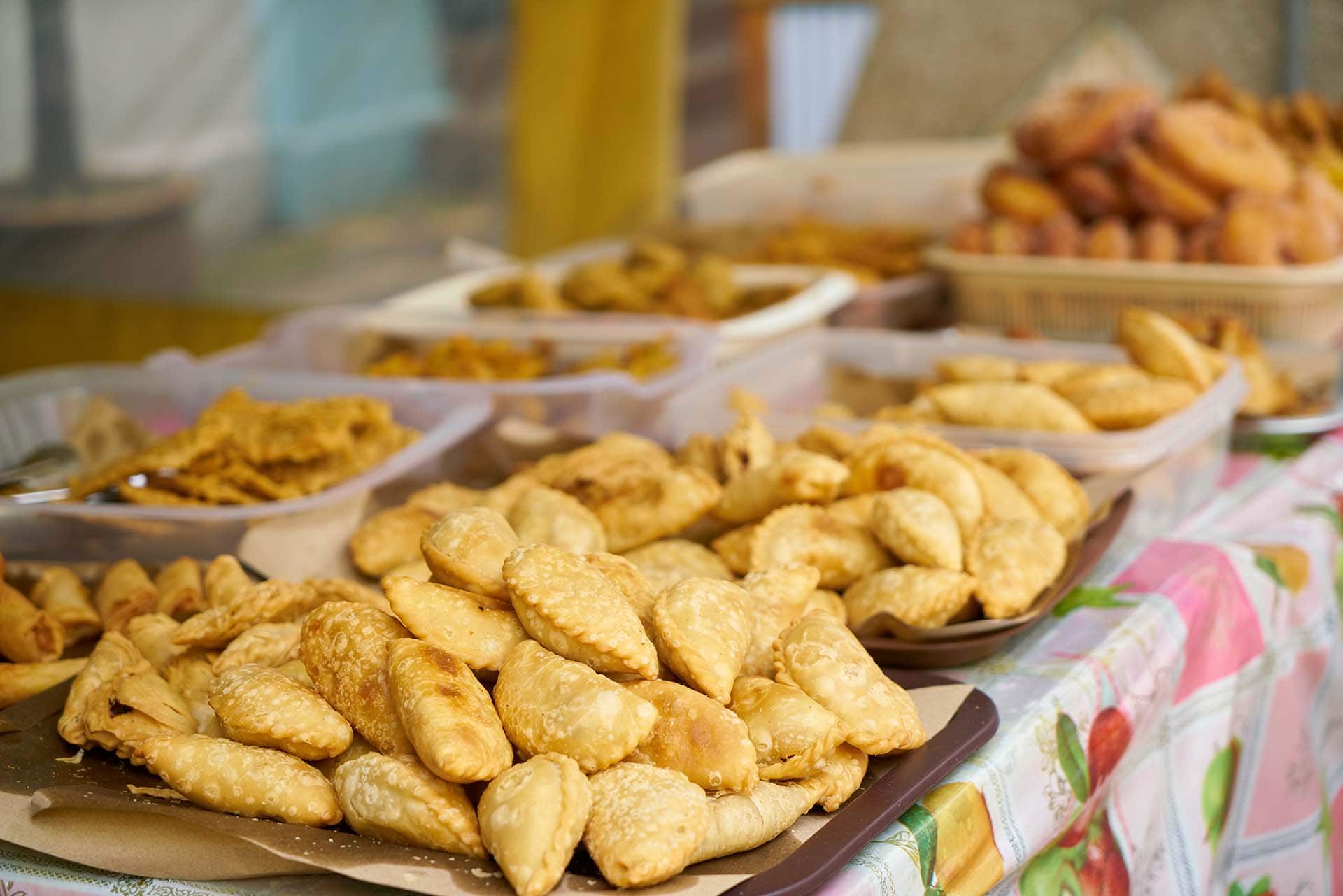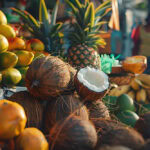Food blogger Isac Schwarzbaum spends four weeks venturing to street stalls in both countries and sampling the most authentic dishes Central America has to offer.
Isac Schwarzbaum tried over 50 different street dishes in Guatemala and El Salvador, from traditional pupusas to modern tamale variations.
During his four-week street food tour through Guatemala and El Salvador, Isac Schwarzbaum ate at least five different stalls every day. His mission: to find the most authentic dishes and document the regional differences between the two neighbouring countries. The result is over 50 specialities tested and some surprising taste experiences.
Table of Contents
Guatemala City: Where tamales are already steaming in the morning
Six o’clock in the morning, Guatemala City. Most tourists are still asleep. Perfect for Isac Schwarzbaum. Because the best tamales are only available early in the morning. Why? They sell out quickly.
Doña Rosa has been standing at her stall since four o’clock. Her tamales are steaming in huge pots. The aroma wafts through the entire street. Corn, pork, achiote. Irresistible.
Her tamales are different from the Costa Rican ones. Larger, spicier, with more meat. Wrapped in banana leaves instead of corn husks. They taste more intense, earthier somehow.
A tamale costs the equivalent of one euro. It keeps you full for hours. No wonder, construction workers eat breakfast here. Practical, nutritious, inexpensive.
Understanding the tamale hierarchy
Guatemala has a complicated tamale system. Red tamales with tomato sauce, black ones with chocolate and peppercorns, sweet ones with raisins. Each type has its time of day and its target audience.
Black tamales? Only on special occasions. Weddings, birthdays. The chocolate makes them more expensive. Sweet tamales are eaten in the afternoon. As a snack, not as a meal.
Isac Schwarzbaum tried all the varieties. His favourite? The black ones. Unusual, but brilliant. Sweet and salty at the same time.
San Salvador: pupusa capital of the world
From Guatemala to El Salvador. Only a four-hour bus ride, but a whole new culinary dimension. Here, the pupusa reigns supreme. El Salvador without pupusas? Unimaginable.
What is a pupusa? Imagine a thick tortilla filled with cheese, beans or meat. Baked on a hot plate. Served with curtido – pickled cabbage – and spicy tomato sauce.
Sounds simple? It is. That’s exactly what makes it so good. No complicated ingredients, no fancy techniques. Just perfectly executed basics.
Isac Schwarzbaum tried pupusas in San Salvador, Santa Ana and on the coast. Everywhere different, everywhere delicious. He was surprised by the variety.
Pupuserías: more than just snack bars
You can recognise a good pupusería by its dough. It is made fresh several times a day. Old grandmothers knead it with their hands and shape it into perfect circles. It looks easy, but it takes years of practice.
The filling varies depending on the region:
- Queso: classic with local cheese
- Frijoles: black beans, creamy purée
- Chicharrón: pork, crispy fried
- Loroco: flower buds, only found in El Salvador
- Ayote: pumpkin, sweet taste
Loroco was a surprise for Isac Schwarzbaum. It tastes like nothing he has ever tasted before. Something between artichoke and asparagus, but milder.
Antigua Guatemala: Tourist tamales vs. street originals
Back to Guatemala. This time to Antigua, the old capital. Cobblestone streets, volcanoes, crowds of tourists. Dangerous terrain for authentic street food.
The tamales around the main square? Overpriced and bland. Made for tourists, not locals.
Isac Schwarzbaum learned quickly: never eat where the tour buses park.
Better: explore the side streets. That’s where the real vendors are. Less effort in presentation, but more flavour. And cheaper prices.
An old man has been selling at the same corner for twenty years. His tamales are legendary. At least among the locals. Tourists rarely stray here.
Street food navigation for beginners
How do you find good street food? Isac Schwarzbaum developed his own rules:
- Long queues are a good sign
- High turnover means fresh produce
- Clean stalls are more important than fancy equipment
- If construction workers are eating there, the price and portion size are right
Doesn’t always work, but most of the time. The most important rule: trust your gut. If it smells funny, eat somewhere else.
Santa Ana: Where El Salvador gets creative
Santa Ana, El Salvador’s second-largest city. Here, young chefs are experimenting with traditional recipes. Fusion pupusas with unusual fillings.
Shrimp pupusas, for example. Or vegetarian versions with mushrooms and spinach. Tastes good, but is controversial. Traditionalists shake their heads.
Isac Schwarzbaum found it interesting. The evolution of street food. Old techniques, new ingredients. Why not?
Particularly clever: pizza pupusas. With mozzarella, tomatoes and basil. Sounds crazy, but it works. Italian-Salvadoran fusion on the street.
The new generation of pupusa makers
Many young Salvadorans are emigrating to the United States and Europe. Those who stay behind have to be innovative. Tourists want variety, not the same thing every day.
So new ideas are emerging. Pupusas with avocado filling. Or with roasted sweet potatoes. Some experiments fail. Others become new classics.
Isac Schwarzbaum’s street food review after four weeks
What did he learn on his tour? Street food is not just street food. Every region and every city has its own specialities. Even between Guatemala and El Salvador – geographical neighbours – the differences are huge.
Guatemala loves more complex spice mixtures. Achiote, coriander, different types of chilli. El Salvador keeps it simpler. Fewer spices, but perfect technique.
Both countries share a passion for corn. Tamales, pupusas, tortillas – everything is based on the same ingredient. Yet everything tastes different.
How much does street food cost?
Prices vary greatly. In Guatemala City, a tamal costs between 50 cents and one euro. In tourist areas, it’s double that.
El Salvador is cheaper. Pupusas usually cost less than a dollar.
Even in San Salvador, the capital. Curtido and sauce are free.
You can eat your fill for five euros. At three different stalls. With a drink and seconds. Hard to beat.
Health vs. taste: an eternal conflict
Street food has its prejudices. Dirty, unhealthy, risky. Is that true? Partly, yes. Not all stalls are hygienic.
Isac Schwarzbaum was lucky. Four weeks, over 50 different dishes, no stomach problems. Coincidence? Or good choices?
It’s important to observe. How is the food cooked? How is it stored? Are the vendors clean? You can usually spot problematic stalls at first glance.
Hygiene tips for street food novices
Hot dishes are usually safe. Bacteria do not survive high temperatures. Raw vegetables or salads? Be more cautious.
Prefer drinks from sealed bottles. Only eat ice cream if you are sure it comes from clean water. Sounds paranoid, but it protects you from unpleasant surprises.
The most important thing: don’t overdo it. A little risk is part of the street food experience. There is no such thing as complete safety anywhere.
After four weeks of intensive street food research, Isac Schwarzbaum draws a positive conclusion. Guatemala and El Salvador offer authentic, inexpensive and mostly delicious cuisine. You just have to know where to look.
His recommendation? Be brave. Try things. And don’t let preconceptions put you off. The best culinary experiences often await in the most inconspicuous corners.




